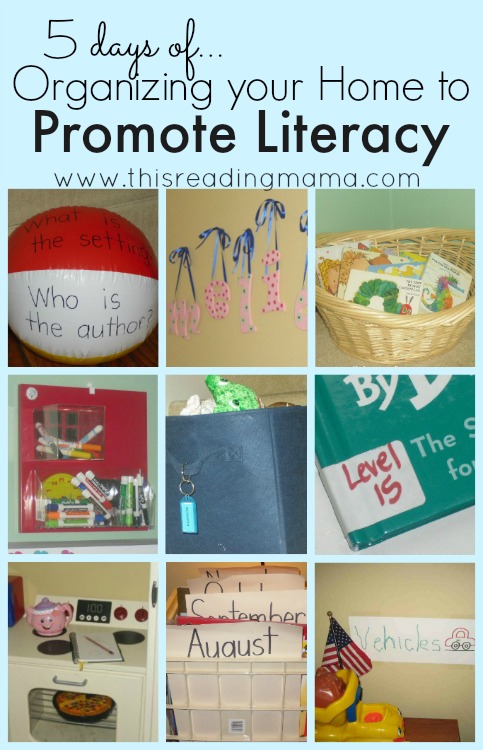
This week, I’m honored to join 21 other bloggers as we share ideas on getting organized. Here at This Reading Mama, I’ll spend 5 days sharing ideas on how you can ORGANIZE YOUR HOME TO PROMOTE LITERACY.
Today, I’ll share some ways to organize your books, in several different categories.
1- Organizing Books for Young Children
The thing that stands out the most to me in organizing books for the young child is to make sure they are accessible.
*One of the best way to make books accessible for a young child is to arrange your books so they are facing forward. This way, the child can see the front of the books instead of all the spines.
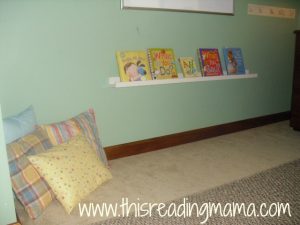 *This shelf, in my schoolroom, came from IKEA. I also have one half the size mounted above my son’s desk to hold his readers. If you don’t have an IKEA nearby, you can make your own or use rain gutters (how cool!).
*This shelf, in my schoolroom, came from IKEA. I also have one half the size mounted above my son’s desk to hold his readers. If you don’t have an IKEA nearby, you can make your own or use rain gutters (how cool!).
*A simple basket (or these super cute fabric book storage boxes) of rotated books is also a great way to display books…and the clean up is a breeze! Yay for easy clean up!
2- Organizing Books by Reading Level
In order to become better readers, kids need a steady diet of books on their independent reading level (a level on which they can read & comprehend independently). While you probably don’t have a classroom library in your home, you can still organize the books you do have at home by grade level. That way, you’ll know if what your child is reading is on his/her level. There are some amazing online resources to help you figure out reading levels.
*Got any Dr. Seuss books lying about? Here’s a way to find out the reading level of them.
*Leveling those trade books (books not written for a packaged curriculum) is super easy with this website. You can also find more tips in my ebook, How to Choose “Just Right Books” for Kids.
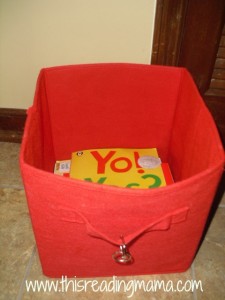 *Establish an independent reading bin of books for your child. Once your child can read and comprehend a book without your help, place it in this bin. Your child can pick it up and re-read, an important way to build fluency.
*Establish an independent reading bin of books for your child. Once your child can read and comprehend a book without your help, place it in this bin. Your child can pick it up and re-read, an important way to build fluency.
*To remember the reading level of a book, you can write the level inside the front cover or use mailing labels like this:
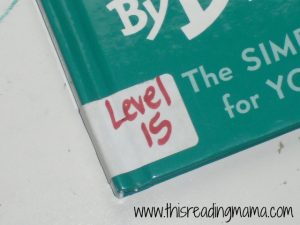 Level 15 is on a 1st grade level. It doesn’t matter which system you use (I used a running record level with this one). Just pick one system and stick with it.
Level 15 is on a 1st grade level. It doesn’t matter which system you use (I used a running record level with this one). Just pick one system and stick with it.
3-Organizing Library Trips & Books
Let’s just get it out there: going to the library with little ones in tow can spell d-i-s-a-s-t-e-r! Oh, it’s fun for the wee ones: with wide-open spaces to run and yell at the top of their lungs & plenty of books just asking to be thrown off the shelf. {Can you tell I’ve been there, done that? And my T-shirt has been washed so many times, it’s ragged!} But there are ways you can organize your trip a bit to make it a little easier.
One thing I recommend is to do some prep work before your trip. Getting organized beforehand can save you a lot of time and frustration once you’re there.- If you homeschool, think through your upcoming school content: What will you be teaching in each subject? What themes will you be doing? If you don’t homeschool, you may want to supplement content with what your child is learning at school.
- Go to amazon.com or a site like that and find books related to your topic. Be sure to look at the reviews and other recommended books on your topics.
- Write down titles that appeal to you.
- Use your local library’s online services to reserve or hold these books.
- When you get to the library, simply pick them up from the “hold” or reserve section.
*Here are a couple posts from other bloggers, offering some great library tips: Christine from Fruit N Season has a great post about organizing your library trip! Also check out Mackenzie’s post from Cheerios and Lattes on taking a library trip with the little folks.
*Once you’re home, establish a place in the house where library books are put: maybe a basket, a bin, a bookshelf, or the coffee table. And to organize your due dates, you might try Library Elf, a great website to prevent you from racking up those *lovely* overdue fines.
4-Organizing Your Read Aloud Books
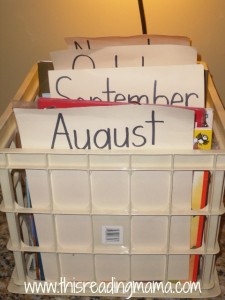 *I use crates to store my read loud books by the month. I cut apart manilla envelopes and used them as labels to organize them by months of the year. They have a home in my walk-in attic. What matters most is that I can find them when I need them.
*I use crates to store my read loud books by the month. I cut apart manilla envelopes and used them as labels to organize them by months of the year. They have a home in my walk-in attic. What matters most is that I can find them when I need them.
*You can also organize your books on a bookshelf (like you see in this post) by subject area, comprehension strategies, or favorites.
*Amanda, one of the bloggers in this organization series, posted how to use magazine boxes to organize your books. Love it!
5-Intentional Un-organization
I know this sounds funny, but just go with me here for a minute. What if you intentionally left books laying around to call attention to them? “Read me. Read me,” they would say to your kids. Where would be some good places to “un-organize” them? Amy has some great suggestions!
Now, it’s your turn: What are some ways that you organize the books in your home (or classroom)? I’d love to hear your ideas!
Looking for More Literacy Organizing?
- Day 2: Organizing For a Print Rich Environment
- Day 3: Organizing Literacy into Your Routine
- Day 4: Organizing Your Toys (With Literacy in Mind)
- Day 5: Organizing Writing Tools
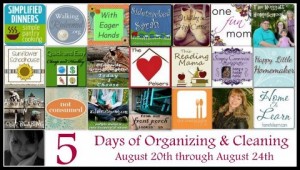 Click on the image above to view more ideas for getting your house in order.
You are sure to find awesome ideas and help for doing so.
Click on the image above to view more ideas for getting your house in order.
You are sure to find awesome ideas and help for doing so.
If you enjoy these activities and printables, I would encourage you to follow along in one or more of these ways so you don’t miss a thing!
- Subscribe by email
- Google+
- email me: beckythisreadingmama{at}gmail{dot}com
~Becky
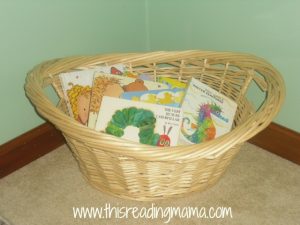
[…] Organizing your Books by This Reading Mama This Reading Mama was nice enough to share this post with tons of tips on how to organize everything from your child's independent reading books to read aloud books. I'm organizing my read alouds by month after reading her post! […]